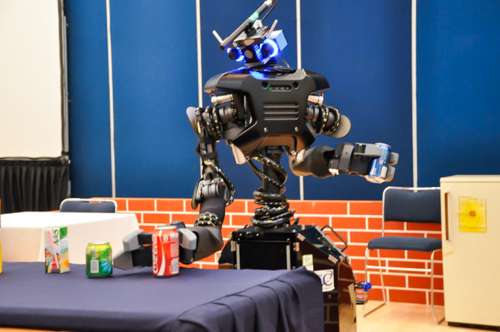Intelligent robots as models for studying human communication

Takayuki Nagai and Tetsuro Nishino share a dream of creating robots with human-like intelligence and, importantly, with "hearts and minds".
"The key to the success of our research is creating robots that can both adapt to their environment and communicate naturally with humans," says Nagai, a professor at the Department of Mechanical Engineering and Intelligent Systems. "This entails enabling robots to learn natural languages and the use of tools by trial and error."
Specific projects include teaching robots to comprehend words by communication and experience, just like a child learns to speak, and object/pattern recognition studies. Recent results include the development of a system to enable a robot to recognize a pair of scissors and identify them as a toll for cutting objects such as paper.
"My role in this research is focused on developing programs for artificial intelligence and natural languages," says Nishino, a professor at the Department of Informatics. "Enabling robots to recognize natural languages is very challenging but essential for our goals."
Intriguing aspects of this area of research are the international competitions that have been launched to assess advances in the development of human-like robots. Specifically, 'RoboCup' is an international competition launched in 1997 to assess advances in research on robotics and artificial intelligence. The ultimate aim of the RoboCup is to develop autonomous robots to play and win a game of soccer against a human team by 2050 according to FIFA rules. Other competitions include 'RoboCupRescue', 'RoboCup@Home', and 'RoboCupJunior'.
"We participate in the "RoboCup@Home" competitions," says Nagai. "In 2008 our robots were awarded first place in both the Japan and international competitions. We were first in the Japan competition this year."
To say that the "RoboCup@Home" is challenging would be an understatement. Tasks include following someone into and out of an elevator and moving to a specified room, finding and fetching 'green tea'.
This multidisciplinary research is focused on developing human-like robots, but Nagai and Nishino have found that they are also looking into the mysteries of human nature, where the robot is the tool.
More information: Muhammad Attamimi, Takaya Araki, Tomoaki Nakamura, Takayuki Nagai, "Visual Recognition System for the Cleaning Task by Humanoid Robots," International Journal of Advanced Robotic Systems: Humanoid, 10:384. DOI: 10.5772/56629, Nov.2013
Tomoaki Nakamura, Komei Sugiura, Takayuki Nagai, Naoto Iwahashi, Tomoki, Toda, Hiroyuki Okada, and Takashi Omori,"Learning Novel Objects for Extended Mobile Manipulation," Journal of Intelligent and Robotic Systems, pp.1-18, Jul. 2011
Takaya Araki, Tomoaki Nakamura, Takayuki Nagai, Kotaro Funakoshi, Mikio, Nakano, Naoto Iwahashi, "Online Object Categorization Using Multimodal Information Autonomously Acquired by a Mobile Robot," Advanced Robotics, 26(17), pp.1995-2020, 2012 (2013 Advanced Robotics Best Paper Award)
Provided by University of Electro Communications



















